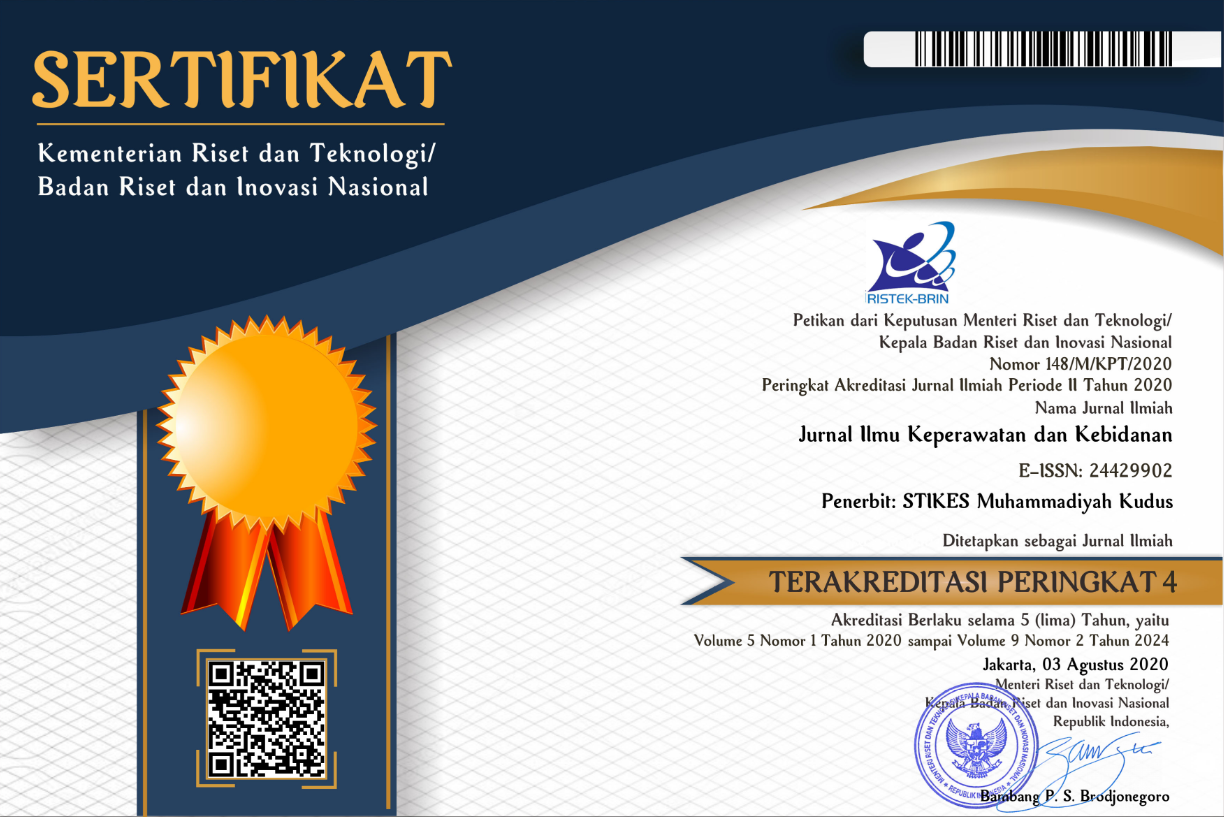MODEL PROBLEM BASED LEARNING KOMPETENSI KOMUNIKASI INTERPERSONAL PADA MAHASISWA KEBIDANAN
Abstract
One method that is widely used to increase student activity in the learning process is the problem based learning method. Problem based learning builds skills, teamwork and communication. PBL is easier to implement and requires less preparation time when compared to classical learning methods
Objective: to apply problem-based learning model to interpersonal communication competence
Method: observational method with problem based learning. The sample in this study were 15 students of the third semester of midwifery study program. Stages of analyzing, solving problems of cases, planning information communication and education, planning the media used in IEC, simulation of interpersonal communication and evaluation. The measuring instrument used is the Interpersonal Communication Competence Scale (ICCS).
Result: the use of problem based learning interpersonal communication model for midwifery students found that most of the communication skills were 86.67% in good category and 13.33% in sufficient category.
Conclusion: the problem based learning method with interpersonal communication competence is very effective in improving student learning outcomes, namely being more confident in conveying the message given to the audience.
Keywords
Full Text:
PDFReferences
Ahmar, H., Budi, P., Ahmad, M., Mushawwir, A., & Khaidir, Z. (2020). Penerapan Model Pembelajaran Problem Based Learning : Literature Review. Jurnal Keperawatan Muhammadiyah, 4(3), 10–17. http://journal.um-surabaya.ac.id/index.php/JKM
Amir, M. T. (2016). Inovasi Pendidikan Melalui Problem Based Learning (Cetakan Ke). Jakarta: Kencana Prenada Media Group
Bagnasco, A., Tolotti, A., Pagnucci, N., Torre, G., Timmins, F., Aleo, G., & Sasso, L. (2016). How to maintain equity and objectivity in assessing the communication skills in a large group of student nurses during a long examination session, using the Objective Structured Clinical Examination (OSCE). Nurse Education Today, 38, 54–60. https://doi.org/10.1016/j.nedt.2015.11.034
Barron, B. J. S., Schwartz, D. L., Vye, N. J., Moore, A., Petrosino, A., Zech, L., & Bransford, J. D. (1998). Doing with Understanding: Lessons from Research on Problem- and Project-Based Learning. Journal of the Learning Sciences, 7(3–4), 271–311. https://doi.org/10.1080/10508406.1998.9672056
Cheraghi, F., Hooshangian, M., Doosti-Irani, A., & Khalili, A. (2021). The effect of peer support approach on communication skills of nursing students in pediatric clinical setting. Nurse Education in Practice, 52(June 2020), 102984. https://doi.org/10.1016/j.nepr.2021.102984
Ghazavi, Z., Lohrasbi, F., & Mehrabi, T. (2010). Effect of communication skill training using group psychoeducation method on the stress level of psychiatry ward nurses. Iranian Journal of Nursing and Midwifery Research, 15(Suppl 1), 395–400. http://www.ncbi.nlm.nih.gov/pubmed/22069416%0Ahttp://www.pubmedcentral.nih.gov/articlerender.fcgi?artid=PMC3208939
Hong, J., Lin, C.-L., & Huang, H.-C. (2007). 模型The Comparison of Problem-based Learning Model and Project-based Learning Model. International Conference on Engineering Education, 4.
Mayasari, T., Kadarohman, A., Rusdiana, D., & Kaniawati, I. (2016). Apakah Model Pembelajaran Problem Based Learning Dan Project Based Learning Mampu Melatihkan Keterampilan Abad 21? Jurnal Pendidikan Fisika Dan Keilmuan (JPFK), 2(1), 48. https://doi.org/10.25273/jpfk.v2i1.24
Pieter, H. Z. (2017). Dasar-dasar komunikasi bagi perawat. Prenada Media.
Saaranen, T., Vaajoki, A., Kellomäki, M., & Hyvärinen, M. L. (2015). The simulation method in learning interpersonal communication competence-Experiences of masters’ degree students of health sciences. Nurse Education Today, 35(2), e8–e13. https://doi.org/10.1016/j.nedt.2014.12.012
Schopper, H., Rosenbaum, M., & Axelson, R. (2016). “I wish someone watched me interview:” medical student insight into observation and feedback as a method for teaching communication skills during the clinical years. BMC Medical Education, 16(1), 1–8. https://doi.org/10.1186/s12909-016-0813-z
DOI: https://doi.org/10.26751/jikk.v13i1.1319
Refbacks
- There are currently no refbacks.
Universitas Muhammadiyah Kudus - LPPM Universitas Muhammadiyah Kudus
Jl. Ganesha 1 Purwosari Kudus 59316
Tel/ Fax +62-291-437218 Email : [email protected]
Jurnal Ilmu Keperawatan dan Kebidanan Indexed by:

This work is licensed under a Creative Commons Attribution-ShareAlike 4.0 International License.













